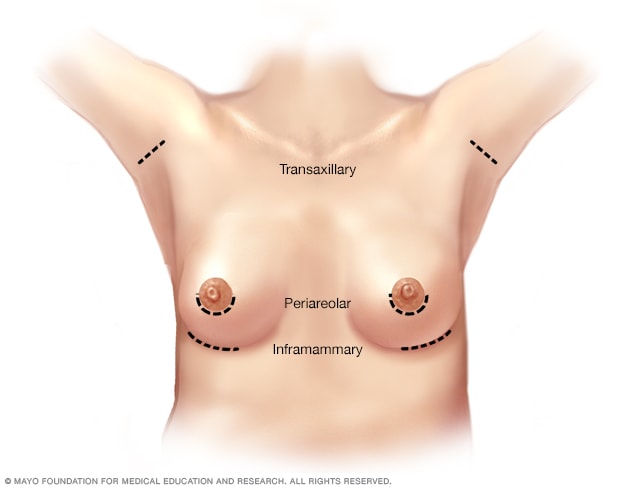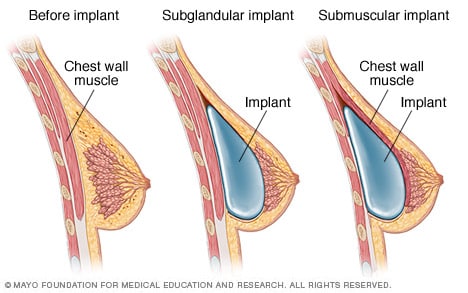Overview
Breast augmentation is surgery to increase breast size. It's also called augmentation mammoplasty. It involves placing breast implants under breast tissue or chest muscles.
For some people, breast augmentation is a way to feel better about themselves. For others, it's part of rebuilding a breast for various conditions.
If you're thinking of having breast augmentation, talk with a plastic surgeon. Make sure you know what the surgery involves, including possible risks and complications, as well as how to take care of yourself after surgery.
Products & Services
Why it's done
Breast augmentation may help you:
- If you think your breasts are small or if one breast is smaller than the other.
- Improve how you feel about yourself.
- Change the size of your breasts after pregnancy or a big weight loss.
- Correct uneven breasts after breast surgery for other conditions.
Discuss your goals with your plastic surgeon so you know what breast augmentation can do for you.
Risks
Breast augmentation has risks, including:
- Scar tissue that changes the shape of the breast implant. This condition is called capsular contracture.
- Breast pain.
- Infection.
- Changes in feeling in the nipple and breast.
- Implant position changes.
- Implant leaks or tears.
Treating these problems could mean more surgery to remove or replace the implants.
Breast implant-associated anaplastic large cell lymphoma
The U.S. Food and Drug Administration (FDA) has found a possible link between breast implants and a type of lymphoma called breast implant-associated anaplastic large cell lymphoma (BIA-ALCL). BIA-ALCL is cancer of the immune system. It's not common.
The FDA believes that people who have had breast implants with textured surfaces have a low but increased risk of getting BIA-ALCL. More research is needed to understand the link between the condition and breast implants.
Systemic symptoms associated with breast implants, also called breast implant illness
Some people with breast implants report symptoms that affect the whole body, also known as systemic symptoms. Reported symptoms include tiredness, memory loss, skin rash, trouble thinking clearly and joint pain. Studies have not shown that breast implants are the cause of these symptoms. But for some people, symptoms get better when the implants are removed.
Experts don't understand the exact link of these symptoms to breast implants. Research to find the link and the cause is ongoing. Talk with your plastic surgeon if you have breast implants and develop any of these symptoms.
If you see changes to your breasts or implants, contact your healthcare professional. Ongoing follow-up visits and screening tests can help find health concerns related to breast augmentation surgery.
How you prepare
Before surgery, you talk with a plastic surgeon about what size breasts you want and how you want your breasts to look and feel. The surgeon talks with you about the types of implants and surgical choices available to you. Implant types include smooth or textured, round or shaped like a teardrop, and saline or silicone.
Read all the information you receive, such as patient information from the maker of the implant you choose. Keep copies for your records.
Healthcare professionals need to review the FDA's Patient Decision Checklist with anyone who wants a breast implant. This is to make sure that people who get breast implants know what implants can do and what the risks are.
Before you decide to have surgery, think about the following:
- Breast implants won't keep your breasts from sagging. Your plastic surgeon may suggest a breast lift as well as breast augmentation to correct sagging breasts.
- Breast implants don't last a lifetime. Implants last about 10 years. Your breasts and body keep aging. Weight gain or weight loss might change the way your breasts look. Also, implants can tear. Implant tears also are called ruptures. These issues can lead to a need for more surgery.
- Mammograms will need more views. If you have breast implants, mammograms involve getting more views of the breast to see all the way around the breast implant.
- Breast implants might affect breastfeeding. Some people can breastfeed after breast augmentation. But for others, breastfeeding is a challenge.
- Insurance doesn't cover breast implants. This is true unless the surgery is needed medically, such as after a mastectomy for breast cancer. Be ready to cover all the bills, including related surgeries or future imaging tests.
- You might need more surgery after breast implant removal. If you decide to have your implants removed, you might want a breast lift or other surgery to make your breasts look better.
- It's best to be screened for silicone implant rupture. The FDA suggests breast imaging 5 to 6 years after you have silicone breast implants put in. This is to check for breast implant rupture. Then, breast imaging is suggested every 2 to 3 years after that. Talk with your plastic surgeon about the type of imaging you'll need after you have your implants put in.
You may need a mammogram before surgery. This is called a baseline mammogram. Your healthcare professional might adjust certain medicines before the surgery too. For example, you may be told not to take aspirin or other medicines that can increase bleeding.
If you smoke, your surgeon will ask you to stop smoking for a time before and after the surgery. This may be for 4 to 6 weeks.
Get someone to drive you home after the surgery and stay with you for at least the first night.
What you can expect
Breast augmentation incision sites

Breast augmentation incision sites
During breast augmentation, the surgeon makes an incision in one of three possible places: the crease under the breast, called inframammary; under the arm, called transaxillary; or around the nipple, called periareolar.
Placement of breast implants

Placement of breast implants
After breast augmentation surgery, the implant lies either behind the glandular tissue in the breast, called subglandular placement, or behind the chest wall muscle, called submuscular placement.
Breast augmentation can be done in a surgery center or in a hospital outpatient facility. Most people go home the same day. A hospital stay is rarely needed after this surgery.
Sometimes, breast augmentation can be done using medicine that numbs only the breast area. This is called local anesthesia. Often, though, general anesthesia is used to bring on a sleep-like state during breast augmentation. Before surgery, talk with your plastic surgeon about the anesthesia that will be used for your procedure.
During the procedure
To put in the breast implant, your plastic surgeon makes a single cut, called an incision, in one of three places:
- The crease under your breast. This is called inframammary.
- Around your nipple. This is called periareolar.
- Under your arm. This is called transaxillary.
After making the cut, the surgeon separates your breast tissue from the muscles and connective tissue of your chest. This makes a pocket either behind or in front of the outer muscle of the chest wall, called the pectoral muscle. The surgeon puts the implant into this pocket and centers it behind your nipple.
Surgeons put saline implants in empty, then fill them with sterile salt water once they're in place. Silicone implants are filled with silicone gel before surgery.
When the implant is in place, the surgeon closes the incision, most often with stitches, also called sutures. Then the surgeon bandages the incision with skin adhesive and surgical tape.
After the procedure
Soreness and swelling are likely for a few weeks after surgery. There may be bruising too. Expect scars to fade over time. But they won't go away completely.
While you heal, it might help to wear a compression bandage or sports bra for support. Your surgeon might prescribe pain medicine as well.
Talk with your surgeon about when you can return to your regular activities. If you don't have to move a lot in your job, you might be able to return to work within a few weeks. For at least two weeks, don't do anything that causes you to strain or raises your pulse or blood pressure. While you heal, your breasts will be sensitive to touch and jarring movements.
Your surgeon might use stitches that don't go away on their own or place drainage tubes near your breasts. If so, you need a follow-up appointment to remove them.
If you have warmth and redness in your breast or if you develop a fever, that could mean you have an infection. Contact your surgeon as soon as you can if you have those symptoms. Also contact your surgeon if you're short of breath or if you have chest pain.
Results
Breast augmentation can change the size and shape of your breasts. And the surgery may improve your body image and self-esteem. But try to keep your expectations realistic. Don't expect perfection.
Also, aging will affect your breasts after augmentation. Weight gain or weight loss might change the way your breasts look too. If you don't like how your breasts look as a result of these changes, you may need more surgery.
Sept. 10, 2024